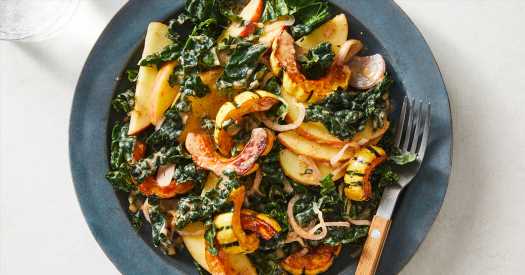Winter Salads Are Better

Here’s how to build a great one.
Send any friend a story
As a subscriber, you have 10 gift articles to give each month. Anyone can read what you share.
By Tanya Sichynsky
What is the internet’s most fundamental purpose if not the sharing of an unsolicited opinion? So here’s one: Winter salads are more delicious, more thrilling, even, than summer salads.
Don’t get me wrong, a platter of salted tomatoes in early August is a pleasure I never deny myself. A summer salad is a celebration of both simplicity and bounty, a chance to revel in what the present can offer. But a winter salad is a paragon of hope. However bleak the day may be, a vibrant medley of flavors and textures will get you through it.
As Melissa Clark wrote this week in a column dedicated to winter salads, the season’s adversity can be a gift. Here’s a case study in building a really good one.
Start with a sturdy base. Cruciferous vegetables — cabbage, cauliflower, kale, broccoli rabe, brussels sprouts, collards — are especially great for this. So, too, are chicories like endive and radicchio, as well as members of the carrot family, which includes carrots (obvious), fennel (less obvious) and celery (it makes sense when you think about it). Take a note from Kay Chun’s crunchy cauliflower salad, and combine any number of them. Or make like Melissa and prepare one vegetable two ways for a roasted and shredded brussels sprouts Caesar salad.
Reach for the unexpected. Offset the bite of your base with something earthy and soft, like mushrooms, or something bright and juicy, like citrus fruit or grapes. Don’t wait until summer to incorporate fruit — oranges are at their peak this time of year and add welcome sweetness to salads like Ali Slagle’s roasted broccoli rabe, white beans and burrata. A scattering of herbs or scallions also does the trick!
Incorporate warmth. A roasted vegetable, warm grains or some gently heated beans can turn a side salad into a proper meal. A warm element can come in any layer of your salad: Roast your sturdy base, as Hana Asbrink does for her roasted fennel and grape salad, or your supporting component, as Ali does in her kale and squash salad with almond-butter vinaigrette (more on that dressing in a sec).
Add something crunchy. Nuts and seeds frizzled in a little oil? I call those nature’s croutons. Cybelle Tondu uses them not only for crunch in her scrunched cabbage salad, but also for richness. And you could always, of course, top a salad with actual croutons.
Dress for success. The best dressings nail the ratio of fat (olive oil, sesame oil, nut oil) to acid (citrus juices, vinegars), and they usually incorporate an emulsifier (miso, mustard, nut butters, yogurt). Dressing does not need to be complicated to be delicious; in this creamy and vegan almond-butter vinaigrette, the nut butter is both the fat and the emulsifier, so you need only three ingredients (not including black pepper and water). When I made it for friends recently, everyone was blown away when they learned what was in it.
Kale and Squash Salad With Almond-Butter Vinaigrette
Go to the recipe.
Crunchy Cauliflower Salad
Go to the recipe.
Roasted Fennel and Grape Salad
Go to the recipe.
One More Thing!
Last week, I asked you all to tell me your cooking resolutions. You delivered! One reader, Jennifer, likes to call them “intentions,” which I love.
Ellen wants to make a buckwheat galette; Vicky wants to have one small dinner party every month, and did so a few Sundays ago; Ruth wants to waste less food and get creative with leftovers; and Harriet wants to build a repertoire of vegan desserts.
And I loved this, from Barbara: “My cooking resolution is simple: Make easy, tasty, homemade vegetarian meals for my household of one, me. Who could be more important for me to nurture and nourish? It’s like putting on one’s own oxygen mask before helping others.”
Words to live by. See you next week!
Email us at [email protected]. Newsletters will be archived here. Reach out to my colleagues at [email protected] if you have questions about your account.
Site Information Navigation
Source: Read Full Article
